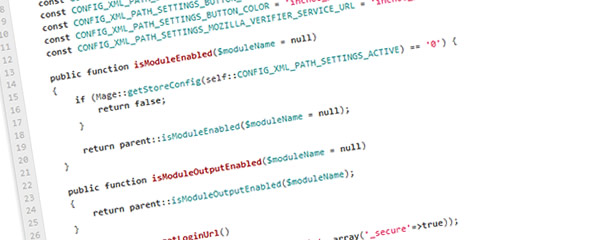The idea behind this article is to show how we can use GIT for Magento extension development. What we want to achieve is a git repository that contains only the files specific to our extension, and not the entire Magento. This kind of repository can then easily be pushed to GitHub or other remote public repository so that entire community benefits from your work.
Entire process described below is a result of a slight frustration of GIT submodules functionality and .gitignore file limitations. Or at least my understanding of the two :).
If we break down the structure of a valid Magento extension, we see that this is not that easy to achieve, or at least not that straight forward with the GIT’s .gitignore file.
Let us dive into the extension structure first. Imagine our company name is Inchoo and our module name is Persona (as in Mozilla Persona).
Here is the folder structure that should be sufficient to hold all of our extension files:
/app/etc/modules/Inchoo_Persona.xml
/app/code/community/Inchoo/Persona/*
/app/design/frontend/default/default/layout/inchoo/persona/*
/app/design/frontend/default/default/template/inchoo/persona/*
/skin/frontend/default/default/css/inchoo/persona/*
/skin/frontend/default/default/js/inchoo/persona/*
/skin/frontend/default/default/images/inchoo/persona/*
/lib/inchoo/persona/*Usually you will see extensions use /app/design/frontend/default/default/layout/inchoo_persona.xml in place of what I personaly prefer /app/design/frontend/default/default/layout/inchoo/persona/somefile.xml. Its all the same to Magento. For the sake of this article, we will stick to my way /app/design/frontend/default/default/layout/inchoo/persona/*.
Now that we have the all the possible directory structure outlined we have a foundation upon which we can build our solution.
Imagine your Magento installation is installed under /Users/branko/www/magento1702_ce/ folder. This is a clean Magento installation, without any custom coded added to it. This installation/folder is not a GIT repository.
Now imagine you need to build Inchoo_Persona when you are done you would like to push it to a GitHub repository, but only the extension related files, not entire Magento.
You create another folder, lets say /Users/branko/www/magento-extension-inchoo-persona/ folder and you create the above mentioned folder structure within it. One you create all of the subfolders you then go back to /Users/branko/www/magento-extension-inchoo-persona/ and do a “git init”. This will be our GIT repository for this extension. Remember, folder /Users/branko/www/magento1702_ce/ that holds our entire Magento installation is not a GIT repository. Folder /Users/branko/www/magento-extension-inchoo-persona/ does not hold any of the Magento files, only the files you create for that extension.
Now we can move on to the next step, that is symlinking.
ln -s /Users/branko/webapps/magento-ext-inchoo-persona/app/etc/modules/Inchoo_Persona.xml /Users/branko/webapps/magento1702_ce/app/etc/modules/Inchoo_Persona.xml
ln -s /Users/branko/webapps/magento-ext-inchoo-persona/app/code/community/Inchoo/Persona/ /Users/branko/webapps/magento1702_ce/app/code/community/Inchoo/Persona
ln -s /Users/branko/webapps/magento-ext-inchoo-persona/app/design/frontend/default/default/layout/inchoo/persona/ /Users/branko/webapps/magento1702_ce/app/design/frontend/default/default/layout/inchoo/persona
ln -s /Users/branko/webapps/magento-ext-inchoo-persona/app/design/frontend/default/default/template/inchoo/persona/ /Users/branko/webapps/magento1702_ce/app/design/frontend/default/default/template/inchoo/persona
ln -s /Users/branko/webapps/magento-ext-inchoo-persona/skin/frontend/default/default/css/inchoo/persona/ /Users/branko/webapps/magento1702_ce/skin/frontend/default/default/css/inchoo/persona
ln -s /Users/branko/webapps/magento-ext-inchoo-persona/skin/frontend/default/default/js/inchoo/persona/ /Users/branko/webapps/magento1702_ce/skin/frontend/default/default/js/inchoo/persona
ln -s /Users/branko/webapps/magento-ext-inchoo-persona/skin/frontend/default/default/images/inchoo/persona/ /Users/branko/webapps/magento1702_ce/skin/frontend/default/default/images/inchoo/persona
ln -s /Users/branko/webapps/magento-ext-inchoo-persona/lib/inchoo/persona/ /Users/branko/webapps/magento1702_ce/lib/inchoo/personaOnce you run these commands (remember you need to use your paths, not mine :)) you will get effect as if your Inchoo_Persona code is living right there in /Users/branko/www/magento1702_ce/ folder, meaning your Magento installation will see the Inchoo_Persona extension.
There is however one more thing you need to do in your Magento installation under /Users/branko/www/magento1702_ce/ folder. You need to login to Magento admin, go under “System > Configuration > Advanced > Developer > Template Settings > Allow Symlinks > Yes” (thanks to Tsvetan Stoyhev for reminding me of this one :)).
Now you can open your favorite text editor / IDE, lets say Netbeans, point it to /Users/branko/www/magento1702_ce/ folder and start working on adding the code files under the Inchoo_Persona directory structure. These code files will actually end up in the proper /Users/branko/webapps/magento-ext-inchoo-persona/ folder and from there you can easily add/commit/push them in your GIT repository. Its important to know that the above mentioned linking is something you need to do only once. Since you symlinked folders, each file / subfolder you create within that folder is visible by Magento.
At first, entire process seems a bit too much to handle, but in practice its really quick. I personally like it because it does two things for me: (1) it forces me to follow and respect Magento extension directory structure, (2) it enables me to have a GIT repository with just my extension files that I can then easily push to GitHub.
In case you find this approach a little “too much”, you can read the Ashley Schroder “Using Git submodules and @import with Modman for Magento” article that demonstrates the use of Colin Mollenhour modman deployment script. It sort of works on a similar approach, utilising the symlinks.
Hope it helps, cheers!



